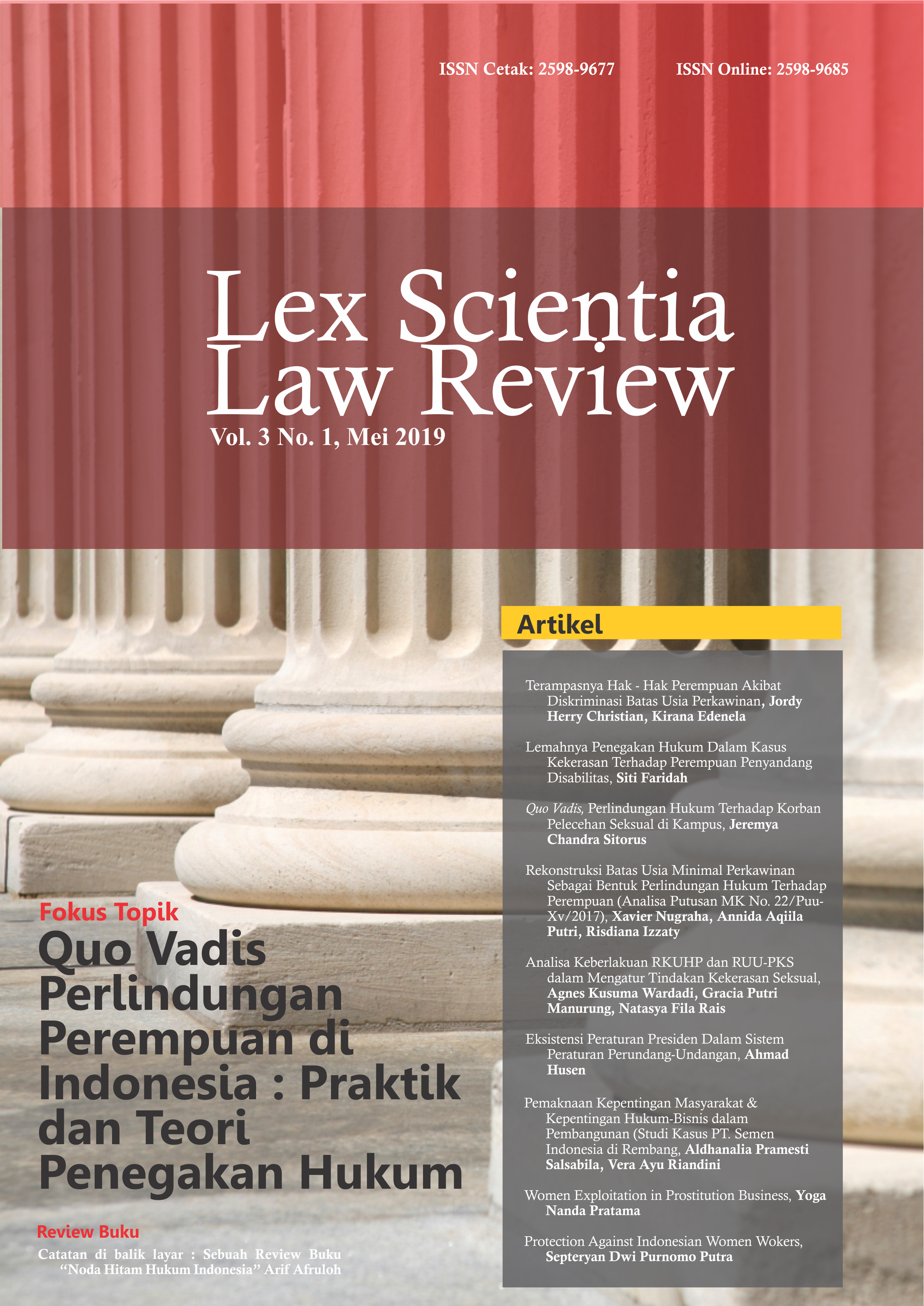Reconstruction of Minimum Age for Marriage as a Form of Legal Protection for Women (Analysis of Constitutional Court Decision No. 22/PUU-XV/2017) Rekonstruksi Batas Usia Minimal Perkawinan Sebagai Bentuk Perlindungan Hukum Terhadap Perempuan (Analisa Putusan MK No. 22/PUU-XV/2017)
Main Article Content
Abstract
Article 7 paragraph (1) Law no. 1 of 1974 concerning Marriage provides that the minimum age for marriage for men is 19 years while for women is 16 years. In the explanation, this aims to maintain the health of husband and wife and offspring. However, the minimum age limit for marriage for women that has been set is contrary to Law no. 35 of 2014 concerning Child Protection which stipulates that a child is someone who is not yet 18 years old. So that makes Article 7 paragraph (1) Law No. 1 of 1974 is discriminatory and has the potential to violate the constitutional rights of girls with the occurrence of child marriage. Constitutional Court Decision No. 22/PUU-XV/2017 states that Article 7 paragraph (1) of Law no. 1 of 1974 has no permanent legal force and gives the legislature 3 years to formulate new norms. If this time period has passed, the minimum age limit for marriage will be harmonized with the age limit for children in Law no. 35 of 2014. The purpose of this study is to describe legal protection for women through setting a minimum age limit for marriage. The research method used is normative research with statutory, conceptual and case approaches.
Article Details
All writings published in this journal are personal views of the authors and do not represent the view of this journal and the author's affiliated institutions. Authors retain the copyrights under this license, see our copyrights notice.
References
Al Uyun, Dhia. "Sic Et Non: Kebebasan Dan Pembatasan Hak Kemudahan Dan Perlakuan Khusus." Yuridika 31, no. 1 (2016).
B. Rubin, Alvin. “Judicial Review in the United States”. LSU Law Digital Commons 40, no. 1 (1979).
Barus, Zulfadli. "Analisis filosofis tentang peta konseptual penelitian hukum normatif dan penelitian hukum sosiologis." Jurnal Dinamika Hukum 13, no. 2 (2013): 307-318.
Djamilah, Djamilah, and Reni Kartikawati. "Dampak perkawinan anak di Indonesia." Jurnal Studi Pemuda 3, no. 1 (2014): 1-16.
Hidayatullah, Faisal. "Analisis Yuridis Putusan Mahkamah Konstitusi Nomor 53/PUU-XV/2017 Berkaitan dengan Penolakan Uji Materi Presidential Threshold dalam Pengusulan Calon Presiden dan Wakil Presiden Pemilihan Umum Serentak 2019." Novum: Jurnal Hukum 5, no. 2 (2018): 104-116.
Hoecke, M.V. Legal doctrine: Which method(s) for what kind of discipline?. (Hart Publishing, Oxford, 2011).
Kartika Rahayu, Muji. Menafsir Demokrasi Konstitusional- Pengertian, Rasionalitas dan Status Demokrasi Konstitusional Indonesia Pasca Amendemen UUD 1945 menurut MK. (Konsorsium Reformasi Hukum Nasional, Jakarta, 2014).
Kharisma, Boga. “Implementasi Batas Usia Minimal dalam Perkawinan Berdasarkan UU Nomor 1 Tahun 1974”. Jurnal Ilmiah Hukum Administrasi Negara 4, no. 1 (2017).
Mandasari, Zayanti. "Politik Hukum Pengaturan Masyarakat Hukum Adat (Studi Putusan Mahkamah Konstitusi)." Jurnal Hukum Ius Quia Iustum 21, no. 2 (2014): 227-250.
Muchtar, Henni. "Paradigma Hukum Responsif (Suatu kajian tentang Mahkamah Konstitusi sebagai Lembaga Penegak Hukum)." Humanus: Jurnal Ilmiah Ilmu-ilmu Humaniora 11, no. 2 (2012): 160-171.
Najih, Mokhammad. "Indonesian Penal Policy: Toward Indonesian Criminal Law Reform Based on Pancasila." JILS (Journal of Indonesian Legal Studies) 3, no. 2 (2018): 149-174.
Nur Rahmah, Wilda. Analisis Putusan Judicial Review Mahkamah Konstitusi No. 30-74/PUU-XII/2014 Tinjauan Uu No.39 Tahun 1999 dan UU No.23 Tahun 2002. Skripsi. (Malang: UIN Maulana Malik Ibrahim Malang, 2016).
Safira, Martha Eri. "Law Is a Tool of Social Engineering dalam Penanganan Tindak Pidana Korupsi di Indonesia Ditinjau dari Hukum Islam dan Perundang-Undangan di Indonesia." Kodifikasia: Jurnal Penelitian Islam 11, no. 1 (2017): 118-133.
Sonata, Depri Liber. "Metode penelitian hukum normatif dan empiris: Karakteristik khas dari metode meneliti hukum." Fiat Justisia Jurnal Ilmu Hukum 8, no. 1 (2014): 15-35.
